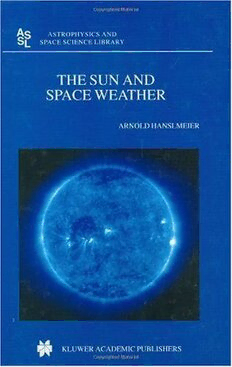Download The Sun and Space Weather (Astrophysics and Space Science Library) PDF Free - Full Version
Download The Sun and Space Weather (Astrophysics and Space Science Library) by A. Hanslmeier in PDF format completely FREE. No registration required, no payment needed. Get instant access to this valuable resource on PDFdrive.to!
About The Sun and Space Weather (Astrophysics and Space Science Library)
What are the terrestrial effects of solar activity and the solar activity cycle? The modern term used for solar terrestrial relations is `Space Weather'. This term describes all external effects on the space environment of the Earth and the Earth's atmosphere. The main driver for space weather is our Sun. Explosive events on the Sun that are modulated by the solar activity cycle lead to enhanced particle emission and short wavelength radiation. This affects satellites: for example surface charging and enhanced drag forces on satellites in low Earth orbit can cause satellite crashes etc. Enhanced radiation also poses a problem for astronauts, especially for extravehicular activities. Another source of space weather effects is space debris and micrometeoroids. Since the Sun is the main source of space weather effects, the first part of the book is devoted to a general introduction to the physics of the Sun. A better understanding of the phenomena underlying solar activity is also important for prediction of solar outbursts and thus for establishing alert systems for space missions and telecommunication systems. The book contains the following topics: possible influence of the Sun on the Earth's climate; the effects of radiation on humans in space and the expected radiation dose from various solar events; disturbances of the Earth's ionosphere and the implications of radio communication at different wavelength ranges; possible hazardous asteroids and meteoroids and their detection; and space debris and special shielding of spacecraft. In the cited literature the reader can find more detailed information about the topics. This book provides an introduction and overview of modern solar-terrestrial physics for students as well as for researchers in the field of astrophysics, solar physics, geophysics, and climate research.
Detailed Information
| Author: | A. Hanslmeier |
|---|---|
| Publication Year: | 2002 |
| ISBN: | 9780306482113 |
| Pages: | 264 |
| Language: | English |
| File Size: | 6.966 |
| Format: | |
| Price: | FREE |
Safe & Secure Download - No registration required
Why Choose PDFdrive for Your Free The Sun and Space Weather (Astrophysics and Space Science Library) Download?
- 100% Free: No hidden fees or subscriptions required for one book every day.
- No Registration: Immediate access is available without creating accounts for one book every day.
- Safe and Secure: Clean downloads without malware or viruses
- Multiple Formats: PDF, MOBI, Mpub,... optimized for all devices
- Educational Resource: Supporting knowledge sharing and learning
Frequently Asked Questions
Is it really free to download The Sun and Space Weather (Astrophysics and Space Science Library) PDF?
Yes, on https://PDFdrive.to you can download The Sun and Space Weather (Astrophysics and Space Science Library) by A. Hanslmeier completely free. We don't require any payment, subscription, or registration to access this PDF file. For 3 books every day.
How can I read The Sun and Space Weather (Astrophysics and Space Science Library) on my mobile device?
After downloading The Sun and Space Weather (Astrophysics and Space Science Library) PDF, you can open it with any PDF reader app on your phone or tablet. We recommend using Adobe Acrobat Reader, Apple Books, or Google Play Books for the best reading experience.
Is this the full version of The Sun and Space Weather (Astrophysics and Space Science Library)?
Yes, this is the complete PDF version of The Sun and Space Weather (Astrophysics and Space Science Library) by A. Hanslmeier. You will be able to read the entire content as in the printed version without missing any pages.
Is it legal to download The Sun and Space Weather (Astrophysics and Space Science Library) PDF for free?
https://PDFdrive.to provides links to free educational resources available online. We do not store any files on our servers. Please be aware of copyright laws in your country before downloading.
The materials shared are intended for research, educational, and personal use in accordance with fair use principles.

